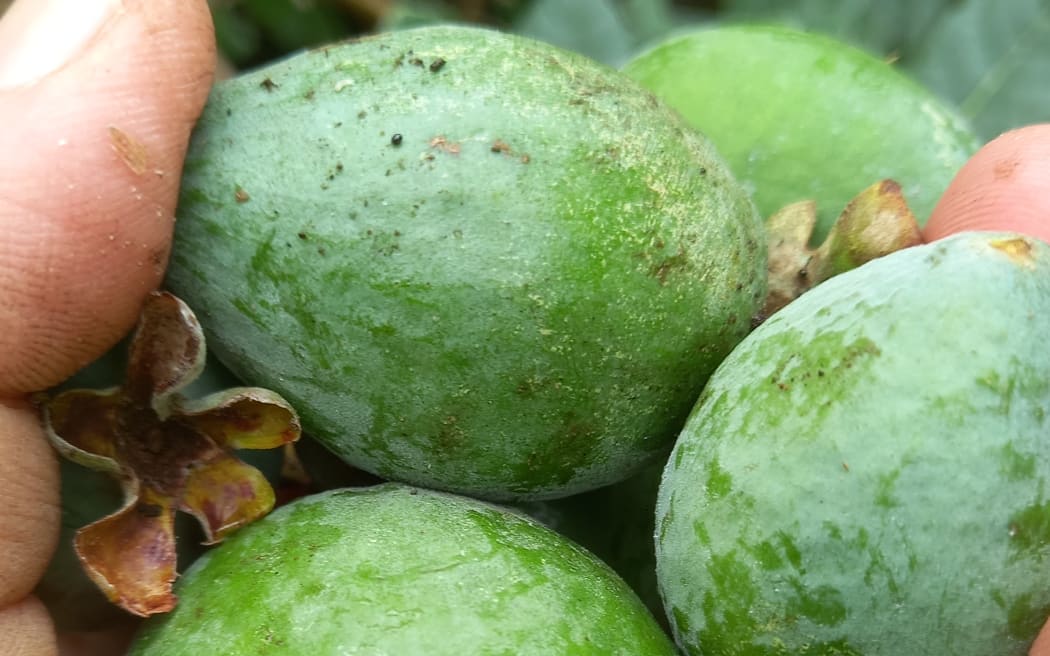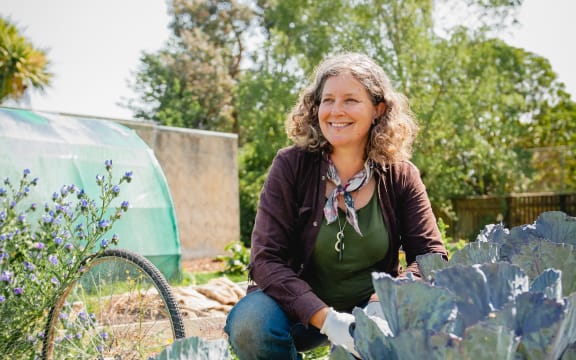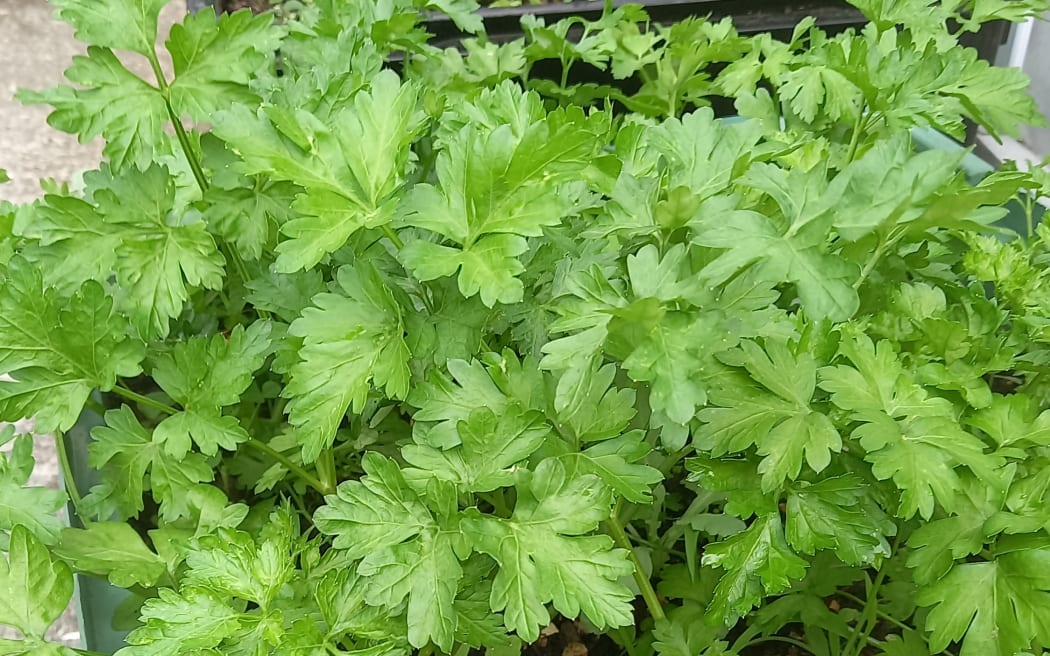There’s not always a ‘right’ or perfect time to do garden jobs - sometimes it’s more about when you can get around to it.
The right time to prune any particular plant can be simply when you happen to pass by with a pair of secateurs in your hand - to quote the late garden maestro Christopher Lloyd.
That said, upcoming holidays and long weekends give some of us a few extra hours to get out in the garden and have a bit of an Autumn clean-up, to mark the passing of the seasons. Some timely interventions now can save work in spring.

After the harvest, tuck in fruit trees with a blanket of mulch for winter. Photo: Hannah Zwartz
Heaps and heaps: Materials such as dead vege plants, new weeds and fallen leaves abound right now, along with warmish, wet weather perfect for building compost heaps. Making compost is the one best thing you can do for your soil, and there are many ways to do it; one of my favourites is to heap up materials, layered with seaweed and grass clippings, directly onto a bed where you will be planting in spring. Sprinkle on some lime or wood ash, innoculate the heap with a bit of live, mature compost if possible, water well and cover with a sack or old woollen blanket - come tomato planting time, you’ll have a weed-free, well nourished bed.
I also make compost in smaller ‘puke’ (mini mounds 50 cm - 1m wide) anywhere I’m hoping to grow pumpkins next year. As long as pumpkins or gourds have their roots in a heap of rich, moist compost, they will happily scramble into the sun to grow over hedges, trees, sheds or weedy banks, making the most of your space without smothering other veges (which can happen when you plant them in the actual vege bed).
Start puke with twiggy prunings now, adding grass clippings, leaves and seaweed in layers over winter. While you’re tucked indoors, your compost heaps can be rotting down for the spring resurrection.
Broad beans: Sow these on Anzac Day, was my grandfather Norm’s advice. After the dawn parade or morning service, he’d head down to the vege beds for a more earthy ritual.
Broad beans make a great winter crop because they sprout at low temperatures. And they’re pretty much foolproof, great for beginners or kids. Poke seeds directly into the soil, at about half a thumb’s depth, add a side dressing of wood ash or lime to prevent chocolate spot disease, then stand back and wait. If you don’t eat all the pods when they’re young, sweet and delicious, older dried beans can be ground up for falafels.
Broad beans need some sort of support - a pole in each corner of the bed, with strings zig-zagged between, will do the job. Another option we are using this year is to plant rows about a metre apart, with trenches between where early potatoes can be planted around September. The broad beans will act as frost shelter, and can then be chopped down to mulch the potatoes in early summer. Grow your own straw, for the ultimate in low food miles!

Gardening expert Hannah Zwartz Photo: Supplied
Harvest: Autumn is the season of mellow fruitfulness, “filling all fruits with ripeness to the core”. This is wonderful, but also can be a burden, because harvest and preserving all take time. Feijoas on wet ground rot quickly - laying a sheet or tarp under the tree will help. Cut up any slightly spotty apples and make a jar of apple cider vinegar (peelings and cores can also be used for this). Pick seeds from silverbeet, lettuce, marigolds and parsley on a dry day, and store for next year.
Pears can be picked while still hard, to ripen in a fruit bowl away from birds and wasps. Don’t rush pumpkins however - prop them on a brick or pot to keep them from rotting where they touch the ground, and wait until the stalk itself is totally brown and shrivelled. If picked before they’re fully ripe, pumpkins won’t have such a full rich, sweet flavour or store as long.

Propped off the ground, this 'Blue Hubbard' pumpkin is waiting for the stalk to totally shrivel before being harvested. Photo: Hannah Zwartz
Plant and sow:
April is THE best month to sow new lawns or top dress bare patches. The ground is still warm, but colder nights make for dew, even without rain. Rake the area flat, add a layer of weed-free lawn mix or potting mix, and sow grass seed, or try a low-mow lawn (my pick is the native Dichondra, available through Kings Seed as Mercury Bay weed - though this is a warmth-lover, best sown in spring in colder areas.) Pegging down shade cloth until the seed sprouts will keep birds from scratching it up.
Winter veg also need to be planted pronto, before it gets too cold (growth is already slowing down). What you plant now will be what you’re eating in spring.
Carrots, beetroot, rocket, peas and mizuna can be direct-sown into the garden.
Seedlings of brassicas (broccoli, cabbage, or cauli), beetroot, celery, and leafy greens like lettuce, parsley, silver beet and kale all like cool, wet weather (especially with a side dressing of compost or sheep pellets).
Plant a paepae garden:
This is the garden that sits at your kitchen door, or by the front steps - I used to call it the ‘socks’ garden as you can pick a salad without putting on boots for a trek in the dark. A portable salad garden, in any large-ish container or pot, helps supply greens and fresh herbs throughout winter.
Plant a punnet of lettuce, a couple of parsleys, tuck in spring onions round the edges - rocket, mizuna, coriander whatever you like to use. Keep picking outer leaves rather than pulling up whole plants, and sprinkle seeds of rocket/mizuna into any gaps. Keep the nutrition up with fortnightly feeds of liquid seaweed.

This paepae garden is planted with juicy Italian parsley, to be kept by the kitchen door for easy winter access. Photo: Hanah Zwartz
Mulch: Around fruit trees, shrubs and perennials, a blanket of mulch will keep roots cosy, holding in warmth and moisture. There are many possibilities - if you can, store a heap of arborists chip to use as needed. The mix of chopped leaves and bark makes for a well balanced mulch, and it’s best when semi-rotted rather than raw. Be generous - a nice thick layer will keep weed seeds (ever-present in bare soil) from germinating.
But be careful not to pile it around tree trunks as this can rot the bark - make a donut shape around the tree instead.
Follow weeding around shrubs and perennials by tucking your plants to bed with a layer of mulch, and you’ll be able to enjoy your garden in spring without a dense growth of new weeds.

